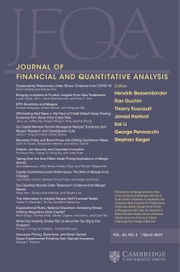Article contents
Social Media Analysts’ Skill: Evidence from Text-Implied Beliefs
Published online by Cambridge University Press: 03 January 2025
Abstract
This paper documents that 56% of nonprofessional social media investment analysts (SMAs) are skilled and declare beliefs that generate positive abnormal returns (ABRs), while 44% produce negative ABRs. 13% of all SMAs are high-skill type and produce a 1-week 3-factor alpha of 61 bps, while the remaining 87% generate only 6 bps. The distinctive features of high-skill SMAs are primarily firm and industry specializations. Although SMAs tend to extrapolate and herd, their expectations are not systematically wrong. For higher-skilled SMAs compared to the less-skilled ones, extrapolation fades more quickly, and herding is lower, consistent with theory.
Information
- Type
- Research Article
- Information
- Creative Commons
- This is an Open Access article, distributed under the terms of the Creative Commons Attribution licence (http://creativecommons.org/licenses/by/4.0), which permits unrestricted re-use, distribution and reproduction, provided the original article is properly cited.
- Copyright
- © The Author(s), 2025. Published by Cambridge University Press on behalf of the Michael G. Foster School of Business, University of Washington
Footnotes
This paper was formerly titled “Should Retail Investors Listen to Social Media Analysts? Evidence from Text-Implied Beliefs.” I thank Stephan Siegel (the editor) and an anonymous referee for their guidance. I am grateful to Grigory Vilkov and Francesco Sangiorgi for their support and suggestions. I received helpful comments from Zhe An (discussant), Fahiz Baba-Yara, Fousseni Chabi-Yo, Tony Cookson (discussant), Alan Crane (discussant), Francesco Franzoni, Amit Goyal, Gustavo Grullon (DESI mentor), Michalis Haliassos, Jonas Happel, Rawley Heimer, Burton Hollifield, Emirhan Ilhan, Yigitcan Karabulut, Nils J. Krakow (discussant), Camelia Kuhnen, Matthias Lassak, Mario Milone (discussant), Marina Niessner (discussant), Altan Pazarbasi, Kim Peinjenburg, Stefan Pohl (discussant), Zacharias Sautner, Nic Schaub, Onur Sefiloglu (discussant), Kelly Shue (discussant), Fabio Trojani (discussant), Raman Uppal, Maximilian Voigt, and Wei Wu (discussant). I thank participants at the following conferences for their helpful comments: 2022 WFA, 2022 DESI/FMA, 2022 CICF, 2022 BFWG, 2022 FDU, 2022 SGF, 2021 FIRS, 2021 NFA, 2021 NOVA Finance PhD Pitch Perfect, 2019 Financial Markets and Corporate Governance conference, 2021 LTI/Bank of Italy Workshop, 2022 Frankfurt Reading Group on Household Finance, 2021 European Retail Investment Conference Doctoral Consortium, 2021 Queen Mary University of London Economics and Finance Workshop, 2021 International French Finance Association conference, 2021 Dauphine Finance PhD Workshop, and Frankfurt School of Finance & Management Brownbag Seminar.
References
- 1
- Cited by

